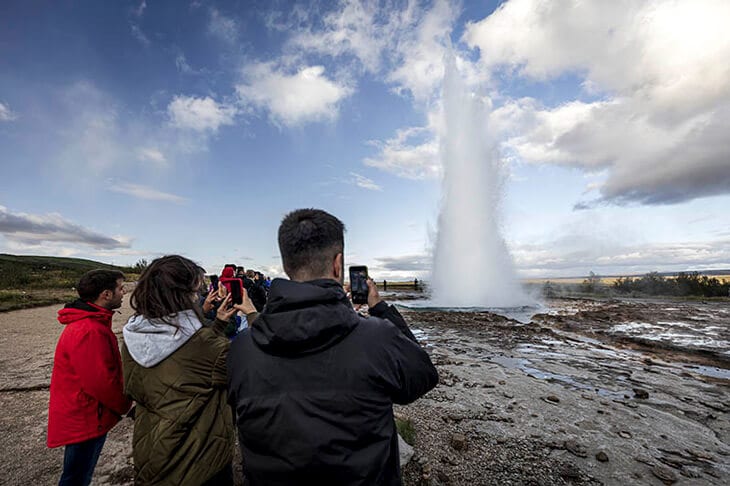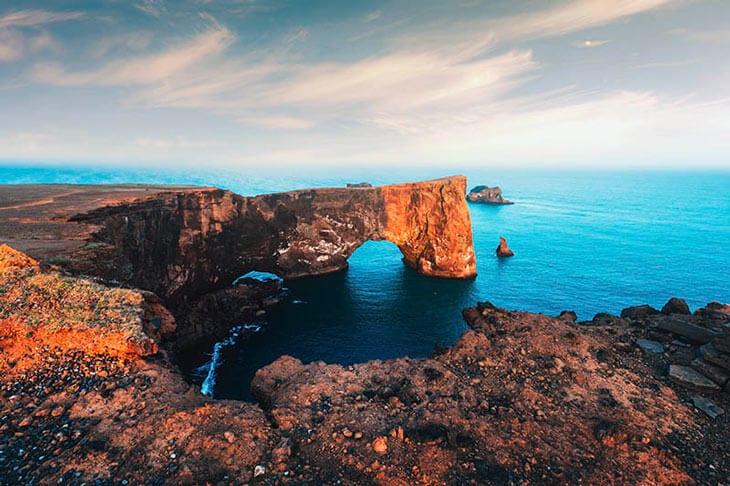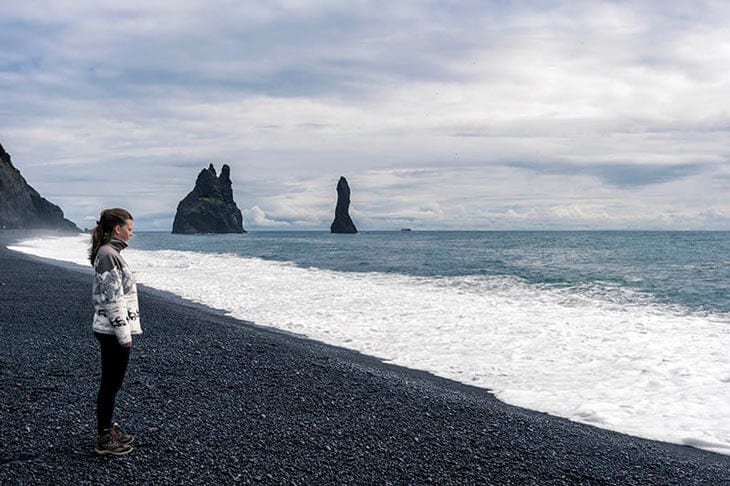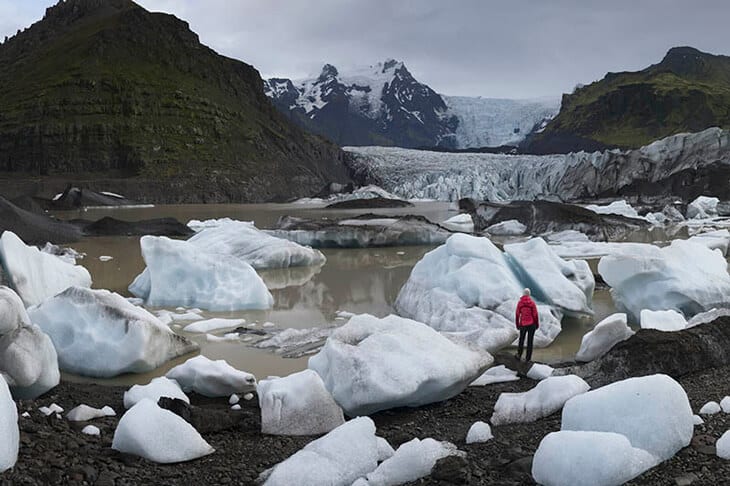Iceland may only be 39,769 square-miles and roughly the size of the state of New York, but packs in the outdoor adventure. It’s also the only country where you can hike a glacier, hit the beach, and explore the capital city on the same day.
Fortunately, you have three whole days to work through this Iceland itinerary, although you should leave room for flexibility and spontaneity. Iceland’s outdoor wonders have a way of captivating your imagination and leaving you wanting more. Use this Iceland itinerary as a guideline to see some of its well-deserved and hidden gems, and discover some new favorites along the way.
Ready to start exploring? Here’s your 3-day Iceland itinerary for your Happy Camper adventure.
Day 1: Explore the Golden Circle
If you’ve already visited Iceland a dozen times and scoured every part of the Golden Circle, you can skip this on your itinerary. Otherwise, it’s a must-see for any traveler looking for a mix of geological intrigue, history, and beauty.
Head out in your Happy Camper and soak in the views of the hardened lava fields and outcroppings along the way. For such a small country, Iceland’s landscape is a startling mix of fjords, black sandy beaches, waterfalls, rolling hills, and lava fields. It’s easy to see why Iceland is so popular with campers whether sleeping under the stars during peak summer months or Northern light-filled winters.
Despite my desire to admonish you for only spending three days in Iceland, you can see and do a lot just by visiting the Golden Circle. The area comprises Iceland’s most treasured attractions. Here’s a quick breakdown of what to expect on your Iceland itinerary today:
Gullfoss Waterfall
Iceland is no stranger to roaring waterfalls tumbling across rugged rocks. Although travelers should exercise caution during winter, the snowy outcroppings and icy edges turn places like Gullfoss into a scene out of a storybook. This attraction also gets bonus points for teaching us a little Icelandic. If you can say “Gullfoss,” then you can say “Golden Falls.”

Gullfoss also has a moving history. Sigríður Tómasdóttir, the daughter of its previous owner, Tómas Tómasson, protested the plans for a nearby hydroelectric power plant that would destroy its beauty. In the early 1900s, she marched barefoot from Gullfoss to Reyakvik during a time the roads were still gravel and dirt. With tattered feet, she threatened to throw herself into the falls, and ultimately, the power plant was never built.
Geysir Hot Springs Area
The Geysir Hot Springs area, once called Hverasandar, is home to the highly active Strokkur Geysir that spouts water 100 feet into the air. You won’t have to wait long to see the action. Stokkur explodes every few minutes to the delight of eager visitors. Explore the area and see other less active geysers, as well as a relatively new Geysir Center. The center offers exhibits on the area, how geysers work, and more information on the area.

There’s a caveat about Geysir. If you’re a diehard geyser enthusiast like a cranky traveler we met (you know who you are), the geysers at Yellowstone in the U.S. may seem more impressive. I say Geysir easily competes based on the surrounding landscape and glorious natural attractions alone. If you can’t get behind the beauty and excitement of exploding geysers along an Icelandic landscape, just stay inside your Happy Camper.
Þingvellir (Thingvellir) National Park
Visit the home of the longest-running Parliament in the world at Þingvellir. The outdoor assembly formed in the early 930 to help settle disputes and give a voice to new arrivals during “The Settlement Period.” Grímur Geitskör was tasked with tapping representatives from surrounding clans and find a meeting location. We can all thank him for finding such a gorgeous spot for exploring.

See the ruins of temporary camps in Búðir, stop by the Þingvallabær farmhouse that’s now a park warden’s office, and wander over to one of the first Icelandic churches called Þingvallakirkja. And because of Þingvellir’s position between two tectonic plates, you can dive or snorkel directly between the crack at Silfra and touch both Europe and North America.
Kerið Crater Lake
Not everyone adds Kerið Crater Lake on the Golden Circle list; however, it’s reasonable to make the stop and worth your time for a quick visit. Surrounded by a volcano with unusual red rock, the neon water of Kerið Crater Lake beckons travelers looking for a little magic. Take a twenty-minute stroll around the crater and stop at the top to stare directly into its epicenter at its tranquil blue wonder.
The entire route covers some 155 miles and loops from Reykjavik and back. Depending on how much time you want to explore the Golden Circle and if you plan to skip a stop, you can also carve out extra time for a fantastic dinner and some nightlife in the capital city.
Pro-tip for your Iceland itinerary: It’s illegal to just set-up camp anywhere around The Golden Circle. Leave yourself time to get back to your campsite, or try the comfortable and legal campsites at Þingvellir, Lake Úlfljótsvatn, Lake Laugarvatn, or Geysir geothermal area.
Day 2: South Coast
Iceland’s South Coast is the reason people fall in love with the country and keep coming back for more. This enchanted area is full of tumbling waterfalls, towering glaciers, black sandy beaches, nature preserves, volcanoes, and majestic landscapes. You can’t see and do it all, but you can pick a few spots for your wishlist and visit again for more.
Seljalandsfoss and Skógafoss Waterfalls
That expression, “If you’ve seen one waterfall, you’ve seen them all,” doesn’t apply in Iceland. You should really see each and every one. For day three on your Iceland itinerary, try Seljalandsfoss and Skógafoss waterfalls and go for a hike or choose to stare at the tumbling water for hours. You’ll be in good company.
Eyjafjallajökull Volcano
Remember our friend Eyjafjallajökull Volcano? It’s the reason so many air travelers got stranded around Europe in 2010. These days, old Eyjafjallajökull behaves itself and provides a fascinating backdrop for safe exploring. You can also stop in the nearby town of Hvolsvöllur to pop into the visitor’s center.
Glacier Hiking
Travelers looking for adventure can walk, climb, and explore Iceland’s glaciers. Some tours also offer snowmobiling to speed across the glaciers for thrill-seekers. Try walking to the top of Sólheimajökull glacier and soak up the views below.
Dyrhólaey Nature Reserve
In 1978, Dyrhólaey became a nature preserve and attracted visitors to its ample birding opportunities and sparkling views. Climb until you see clear views of the Mýrdalsjökull glacier and Reynisdrangar’s black coastline. Or you can keep going and look for a castle-shaped lighthouse greeting visitors to “the hill island with the door hole.”

Snap some photos of the stunning Dyrhólaey rock arch and cliffs before calling it a day. Dyrhólaey is also near the town of Vik, providing a lovely stop for lunch or a walk through this historic village.
Reynisfjara Black Sand Beach
Reynisfjara is world-famous for its black sand beach stretching along the South Coast of Iceland. Icelandic folklore weaves tales about the beach’s unmissable rocky sea stacks. Once considered trolls that tried to pull ships from the ocean, they turned into stone when dawn broke.

Aside from not angering the trolls, there are some real threats around this place to consider. Reynisfjara has “sneaker waves” that, as the name implies, sneak up on you. Visit with a companion, stay clear of the water on windy days, and don’t turn your back on the waves. Either the waves or the trolls could take you down.
Diamond Beach
Another one of Iceland’s black volcanic sand beaches, Diamond Beach is a breathtaking experience. It’s common to see icebergs teetering along the shoreline, where the contrast of black, inky sand with white and blue icebergs feels surreal. And if you decide to turn your South Coast adventure into a two-day excursion, you can come back again and again. Diamond Beach always looks different from one day to the next.
Pro-tip for your Iceland itinerary: For camping along the South Coast, try Vik Camping, Þakgil, or Campsite Grindavik – Tjaldsvaedi, among other spots. You can also find our list of free and cheap Icelandic camping here.
Day 3: Vatnajökull National Park or Reykjavik
Day three on your Iceland tour is a good time to mix things up and decide whether you want to wrap-up your South Coast adventure, explore Reykjavik, or see one last glorious park-like Vatnajökull. Also situated along the South Coast, Vatnajökull National Park is home to wilderness area Skaftafell famous for its hiking and Svartifoss waterfall. You could spend the day here, exploring the great outdoors in an area known as a “hiker’s paradise.”

If you’re feeling a little weary, you can decide to split up day three and head back to Reykjavik early to enjoy some city life. I’m a fan of spontaneous wandering, especially in a safe city with traditional Icelandic dishes, shops, nightlife, and pubs. However, if you want to squeeze in a few stops, try the iconic Hallgrimskirkja church, National Museum of Iceland, or Perlan museum to see more of the area and learn about Iceland’s Viking roots.
Pro-tip for your Iceland itinerary: You can camp inside Vatnajökull National Park at the designated grounds, including Skaftafell Camping. If you want to stay in or near the city, try Hafnarfjörður Camping or Camper Resort.
There’s plenty more to see and do in this stunning country, but a 3-day Iceland itinerary gives you a solid foundation to step off of from your Happy Camper. Just make sure your travels include plans to come back for more.
Back